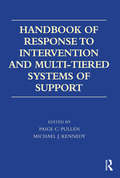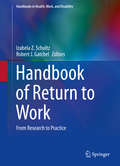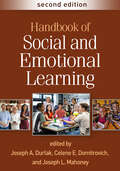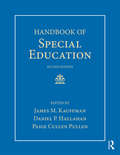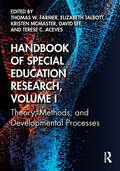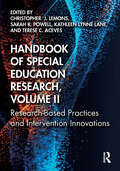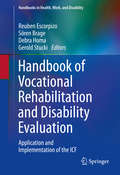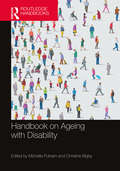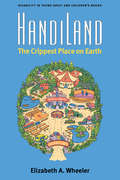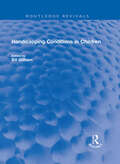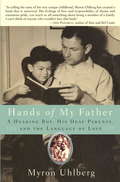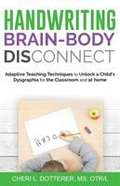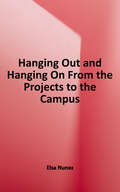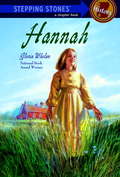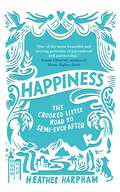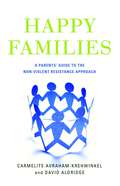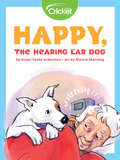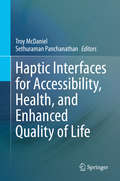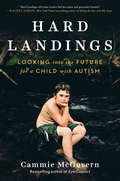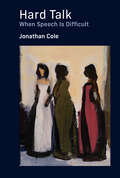- Table View
- List View
Handbook of Response to Intervention and Multi-Tiered Systems of Support
by Paige C. Pullen Michael J. KennedyOf the many issues facing special education (and general education) today, it is difficult to imagine one more important or timely than response to intervention (RTI). Almost overnight RTI has become standard practice across the nation. Unfortunately, RTI remains ill-defined, falls far short of its evidence-based practice goal, is almost invariably misused, and often results in more harm than good. Nevertheless, as a conceptual framework RTI has great potential for ensuring that students with disabilities receive appropriate, evidence-based instruction. The mission of this handbook is to present a comprehensive and integrated discussion of response to intervention (RTI) and its relation to multi-tiered systems of support (MTSS) in both special education and general education. Although the two terms are currently used interchangeably, distinct differences exist between them. Therefore, chapters are dedicated to distinguishing the two concepts—RTI and MTSS—and describing each one’s unique role in both general and special education. In addition, the authors recommend a third term, Multi-Tiered Instruction, to differentiate the practices related to the purpose of the specific intervention.
Handbook of Return to Work
by Izabela Z. Schultz Robert J. GatchelThis comprehensive interdisciplinary synthesis focuses on the clinical and occupational intervention processes enabling workers to return to their jobs and sustain employment after injury or serious illness as well as ideas for improving the wide range of outcomes of entry and re-entry into the workplace. Information is accessible along key theoretical, research, and interventive lines, emphasizing a palette of evidence-informed approaches to return to work and stay at work planning and implementation, in the context of disability prevention. Condition-specific chapters detail best return to work and stay at work practices across diverse medical and psychological diagnoses, from musculoskeletal disorders to cancer, from TBI to PTSD. The resulting collection bridges the gap between research evidence and practice and gives readers necessary information from a range of critical perspectives. Among the featured topics: Understanding motivation to return to work: economy of gains and losses. Overcoming barriers to return to work: behavioral and cultural change. Program evaluation in return to work: an integrative framework. Working with stakeholders in return to work processes. Return to work after major limb loss. Improving work outcomes among cancer survivors. Return to work among women with fibromyalgia and chronic fatigue syndrome. The Handbook of Return to Work is an invaluable, unique and comprehensive resource for health, rehabilitation, clinical, counselling and industrial psychologists, rehabilitation specialists, occupational and physical therapists, family and primary care physicians, psychiatrists and physical medicine and rehabilitation as well as occupational medicine specialists, case and disability managers and human resource professionals. Academics and researchers across these fields will also find expert guidance and direction in these pages. It is an essential reading for all return to work and stay at work stakeholders.
Handbook of Social and Emotional Learning
by The Weissberg ScholarsThe definitive work on social and emotional learning (SEL) research and practice is now in an extensively revised second edition, featuring all-new and thoroughly updated chapters. The world&’s leading SEL scholars describe state-of-the-art interventions that build students' competencies for managing emotions, showing empathy for others, forming supportive relationships, and making responsible decisions. The scientific underpinnings of SEL are explored and its impact on academic achievement and behavior is examined. The Handbook discusses ways to assess SEL and design effective, developmentally and culturally informed programs for students in preschool through secondary school settings and beyond. New to This Edition *Reflects a decade of significant advances in research, policy, and implementation. *New and expanded topics--equity, culturally responsive practice, multi-tiered systems of support, adult SEL, technology tools and applications, mental health, scaling up successful interventions, and more. *Six chapters on international SEL efforts, discussing both developed and developing countries. *Every chapter concludes with Key Takeaway Points.
Handbook of Special Education
by Daniel P. Hallahan James M. Kauffman Paige Cullen PullenThe purpose of the Handbook of Special Education is to help profile and bring greater clarity to the already sprawling and continuously expanding field of special education. To ensure consistency across the volume, chapter authors review and integrate existing research, identify strengths and weaknesses, note gaps in the literature, and discuss implications for practice and future research. The second edition has been fully updated throughout to take into account recent changes to federal laws as well as the most current academic research, and an entirely new section has been added on research methods in special education.
Handbook of Special Education Research, Volume I: Theory, Methods, and Developmental Processes
by David Lee Terese C. Aceves Elizabeth Talbott Thomas W. Farmer Kristen McMasterDivided into two volumes, Handbook of Special Education Research provides a comprehensive overview of critical issues in special education research. This first volume addresses key topics in theory, methods, and development, exploring how these three domains interconnect to build effective special education research. Each chapter features considerations for future research and implications for fostering continuous improvement and innovation. Essential reading for researchers and students of special education, this handbook brings together diverse and complementary perspectives to help move the field forward.
Handbook of Special Education Research, Volume II: Research-Based Practices and Intervention Innovations
by Terese C. Aceves Kathleen Lynne Lane Sarah R. Powell Christopher J. LemonsDivided into two volumes, the Handbook of Special Education Research provides a comprehensive overview of critical issues in special education research. Volume II addresses research-based practices, offering a deep dive into tiered systems of support and advances in interventions and assessments, as well as socially, emotionally, culturally, and linguistically relevant practices. Each chapter features considerations for future research and implications for fostering continuous improvement and innovation. Essential reading for researchers and students of special education, this handbook brings together diverse and complementary perspectives to help move the field forward.
Handbook of Vocational Rehabilitation and Disability Evaluation
by Reuben Escorpizo Sören Brage Debra Homa Gerold StuckiThis book presents the state of the art in the application and implementation of the WHO's International Classification of Functioning, Disability and Health (ICF) in the areas of vocational rehabilitation as a primary topic and disability evaluation as a secondary topic. Application of the ICF and implementation strategies toward a holistic and comprehensive approach to work disability and vocational rehabilitation programs are presented along with clinical cases and exercises. The ICF as a topic in health and disability has been gaining momentum since its approval by the World Health Assembly in 2001, and great progress has been made since then. However, the integration if the ICF in the realm of vocational rehabilitation has been lacking despite the fact that work and employment are a major area in people's lives, particularly those who have work disability. This book will advance the professional practice of vocational rehabilitation, rehabilitation counseling, occupational medicine, and allied health science.
Handbook on Ageing with Disability
by Christine Bigby Michelle PutnamMainstream gerontological scholarship has taken little heed of people ageing with disability, and they have also been largely overlooked by both disability and ageing policies and service systems. The Handbook on Ageing with Disability is the first to pull together knowledge about the experience of ageing with disability. It provides a broad look at scholarship in this developing field and across different groups of people with disability in order to form a better understanding of commonalities across groups and identify unique facets of ageing within specific groups. Drawing from academic, personal, and clinical perspectives, the chapters address topics stemming from how the ageing with disability experience is framed, the heterogeneity of the population ageing with disability and the disability experience, issues of social exclusion, health and wellness, frailty, later life, and policy contexts for ageing with disability in various countries. Responding to the need to increase access to knowledge in this field, the Handbook provides guideposts for researchers, practitioners, and policy makers about what matters in providing services, developing programmes, and implementing policies that support persons ageing with long-term disabilities and their families.
HandiLand: The Crippest Place on Earth (Corporealities: Discourses Of Disability)
by Elizabeth A WheelerHandiLand looks at young adult novels, fantasy series, graphic memoirs, and picture books of the last 25 years in which characters with disabilities take center stage for the first time. These books take what others regard as weaknesses—for instance, Harry Potter’s headaches or Hazel Lancaster’s oxygen tank—and redefine them as part of the hero’s journey. HandiLand places this movement from sidekick to hero in the political contexts of disability rights movements in the United States, the United Kingdom, and Ghana. Elizabeth A. Wheeler invokes the fantasy of HandiLand, an ideal society ready for young people with disabilities before they get there, as a yardstick to measure how far we’ve come and how far we still need to go toward the goal of total inclusion. The book moves through the public spaces young people with disabilities have entered, including schools, nature, and online communities. As a disabled person and parent of children with disabilities, Wheeler offers an inside look into families who collude with their kids in shaping a better world. Moving, funny, and beautifully written, HandiLand: The Crippest Place on Earth is the definitive study of disability in contemporary literature for young readers.
Handicapping Conditions in Children (Routledge Revivals)
by Bill GillhamFirst published in 1986, Handicapping Conditions in Children provides an accessible overview of a wide range of handicapping conditions and their remediation, and gives a balanced perspective on the medical, educational and social issues. It will therefore be of value to a wide audience in these professions as well as to students and parents. Each chapter deals with one specific area but is presented to cover: description of the condition and its aetiology; its prevalence in the population and relatives; developmental characteristics; special problems and needs; educational and social provision; the potential for the future; and further reading lists. The book does not include every possible condition, but concentrates on those that are most frequent or problematic. This book is a reissue originally published in 1986. The language used is a reflection of its era and no offence is meant by the Publishers to any reader by this republication
Handmade Alphabet
by Laura RankinThe American Sign Language manual alphabet in illustration. Unfortunately images have been omitted.
Hands of My Father
by Myron UhlbergBy turns heart-tugging and hilarious, Myron Uhlberg's memoir tells the story of growing up as the hearing son of deaf parents--and his life in a world that he found unaccountably beautiful, even as he longed to escape it."Does sound have rhythm?" my father asked. "Does it rise and fall like the ocean? Does it come and go like the wind?"Such were the kinds of questions that Myron Uhlberg's deaf father asked him from earliest childhood, in his eternal quest to decipher, and to understand, the elusive nature of sound. Quite a challenge for a young boy, and one of many he would face. Uhlberg's first language was American Sign Language, the first sign he learned: "I love you." But his second language was spoken English--and no sooner did he learn it than he was called upon to act as his father's ears and mouth in the stores and streets of the neighborhood beyond their silent apartment in Brooklyn. Resentful as he sometimes was of the heavy burdens heaped on his small shoulders, he nonetheless adored his parents, who passed on to him their own passionate engagement with life. These two remarkable people married and had children at the absolute bottom of the Great Depression--an expression of extraordinary optimism, and typical of the joy and resilience they were able to summon at even the darkest of times.From the beaches of Coney Island to Ebbets Field, where he watches his father's hero Jackie Robinson play ball, from the branch library above the local Chinese restaurant where the odor of chow mein rose from the pages of the books he devoured to the hospital ward where he visits his polio-afflicted friend, this is a memoir filled with stories about growing up not just as the child of two deaf people but as a book-loving, mischief-making, tree-climbing kid during the remarkably eventful period that spanned the Depression, the War, and the early fifties.From the Hardcover edition.
Hands of My Father: A Hearing Boy, His Deaf Parents, and the Language of Love
by Myron Uhlberg<P>By turns heart-tugging and hilarious, Myron Uhlberg's memoir tells the story of growing up as the hearing son of deaf parents--and his life in a world that he found unaccountably beautiful, even as he longed to escape it."Does sound have rhythm?" my father asked. "Does it rise and fall like the ocean? Does it come and go like the wind?" Such were the kinds of questions that Myron Uhlberg's deaf father asked him from earliest childhood, in his eternal quest to decipher, and to understand, the elusive nature of sound. Quite a challenge for a young boy, and one of many he would face. Uhlberg's first language was American Sign Language, the first sign he learned: "I love you." <P>But his second language was spoken English--and no sooner did he learn it than he was called upon to act as his father's ears and mouth in the stores and streets of the neighborhood beyond their silent apartment in Brooklyn. Resentful as he sometimes was of the heavy burdens heaped on his small shoulders, he nonetheless adored his parents, who passed on to him their own passionate engagement with life. These two remarkable people married and had children at the absolute bottom of the Great Depression--an expression of extraordinary optimism, and typical of the joy and resilience they were able to summon at even the darkest of times. <P>From the beaches of Coney Island to Ebbets Field, where he watches his father's hero Jackie Robinson play ball, from the branch library above the local Chinese restaurant where the odor of chow mein rose from the pages of the books he devoured to the hospital ward where he visits his polio-afflicted friend, this is a memoir filled with stories about growing up not just as the child of two deaf people but as a book-loving, mischief-making, tree-climbing kid during the remarkably eventful period that spanned the Depression, the War, and the early fifties.
Hands-On Parenting: A Resource Guide for Parents who are Blind or Partially Sighted
by Debbie BaconChapters include topics such as: newborns and the basics, communicating with your child, organizing and children's clothing, toilet training, traveling with your children, social issues for blind parents, and toys and game suggestions for families.
Handsigns: A Sign Language Alphabet
by Kathleen FainIn this book, you can learn how to shape your hand into each letter of the ASL alphabet, while learning about such animals such as the rhinoceros, the koala, or the xenosaurus.
Handwriting Brain-Body Disconnect: Adaptive teaching techniques to unlock a child's dysgraphia for the classroom and at home
by Cheri L DottererThere is a misconception about dyslexia, dysgraphia, and dyscalculia. Some people use the terms interchangeably. Simply put: dyslexia is defined as difficulty with reading; dysgraphia is defined as difficulty with writing; and dyscalculia is defined as difficulty with math concepts. Each topic is much more complicated. This book is written for teachers, parents, occupational therapists transitioning to school-based practice, and other related service professionals, focusing on dysgraphia.
Hanging Out and Hanging On: From the Projects to the Campus
by Elsa NunezThis book chronicles the progress of students from Hartford and Manchester, Connecticut, who are enrolled in the Dual College Enrollment Program (DCEP) at Eastern Connecticut State University. <p><p>“Hanging Out” sets the stage for describing the program by first reaching back in time to tell of Dr. Núñez’s own beginnings in Puerto Rico and Newark, New Jersey, of her struggles as a non-English speaking elementary school student and her triumphs in high school and college. The next section of the book describes the lives of Latinos in Connecticut and the social, economic, and educational challenges they have faced over time. Her personal experiences and desire to improve the lives of the underprivileged led Dr. Núñez to create the DCEP Program. <p><p>Through the words of faculty and staff and the personal accounts of six DCEP students, you will read stories of desperation and hope, of struggle and triumph, of heart-breaking failure and stunning success. We hope their story can serve as a model for other communities to follow.
Hannah
by Gloria Whelan Leslie BowmanNine-year-old Hannah would do almost anything to go to school with all the other children in town. But Hannah is blind, and her parents keep her at home, where she is safe. Then Lydia Robbin, a strong-willed teacher, comes to town and convinces Hannah's parents to send her to school. At first Hannah is overjoyed. But she soon learns that there are many obstacles--and people--that stand in her way. Hannah will need tremendous courage to prove to her classmates, her parents, and herself that Miss Robbin was right to believe in her. History Stepping Stones now feature updated content that emphasizes Common Core and today's renewed interest in nonfiction. Perfect for home, school, and library bookshelves!From the Trade Paperback edition.
Happiness: How to Build a Family out of Love and Spare Parts
by Heather HarphamReese Witherspoon's Book Club Pick 2018 An Amazon Best Memoir of the Month One of Elle Magazine's Best Books of 2017 Goodreads Best of the Month Daily Beast, &“Books I Can&’t Live Without&” Good Housekeeping, Best New Books for Summer Book Riot, 100 Must Read Books about Happiness A page-turning, shirt-grabbing true story that follows a one-of-a-kind family required to make nearly unimaginable choices Happiness starts out as a charming courtship between hopelessly attracted opposites: Heather, an out-going, theatre-performing California girl, and Brian, an intellectual New Yorker with an unwavering writing routine. But when Heather falls pregnant, their magical interlude abruptly ends—Brian loves her, only he doesn&’t want kids. So Heather decides to have their baby alone. Mere hours after Gracie&’s arrival, Heather&’s bliss is interrupted when a nurse wakes her, 'Get dressed, your baby is in trouble.' This is not how Heather had imagined motherhood. As concerns for her health grow, Brian and Heather begin a cautious return to each other. Happiness transforms heartbreak and parental fears into a lyrical meditation on love and happiness, in all their crooked configurations.
Happy Families
by David Aldridge Carmelite Avraham-KrehwinkelParenting a severely disruptive child can be exhausting and demoralizing to the point where breaking the cycle of bad behaviour seems an impossible task. Happy Families offers a realistic, step-by-step, practical approach to tackling destructive behaviour that helps parents regain control and establish harmony within the family. Using hands-on techniques based on the principles of non-violent resistance, each chapter deals with a different stage of the process - from communicating to the child an unwavering determination that the situation will change and enlisting the support of family and friends, to taking positive action in a way that avoids escalation. General advice such as how to respond constructively and consistently to provocation is included throughout, and morale-boosting tips encourage flagging parents to persevere with the approach. Happy Families will empower despairing parents and caregivers who seek to contain, counter and positively re-direct the aggression they face from children in distress, resulting in deep-felt and lasting change.
Happy, the Hearing Ear Dog
by Susan Yoder AckermanTyler's grandma is deaf, so she gets Happy, a specially trained dog who hears for her.
Haptic Communication: The Helen Keller National Center's American Edition of the Original Title Haptisk Kommunikasjon
by Hellen Keller National Center Hildebjørg Karlsen Bjørge Kathrine Goborg Rehder Magni ØveråsThanks to a new, emerging system of touch signals, people who are DeafBlind and blind now can have access to visual and environmental information at the same time as a sighted-hearing person.
Haptic Interfaces for Accessibility, Health, and Enhanced Quality of Life
by Troy McDaniel Sethuraman PanchanathanThis book is the first resource to provide in-depth coverage on topical areas of assistive, rehabilitative, and health-related applications for haptic (touch-based) technologies. Application topics are grouped into thematic areas spanning haptic devices for sensory impairments, health and well-being, and physical impairments which are illustrated in this book. A diverse group of experts in the field were invited to contribute different chapters to provide complementary and multidisciplinary perspectives. Unlike other books on haptics, which focus on human haptic perception, specific modalities of haptics (e.g., realistic haptic rendering), or broadly cover the subfields of haptics, this book takes an application-oriented approach to present a tour of how the field of haptics has been advanced with respect to important, impactful thematic focuses.Under Theme 1 “Sensory Impairments”, haptics technologies to support individuals with sensory impairments is presented which includes: Spatial awareness in sensory impairments through touch; Haptically-assisted interfaces for persons with visual impairments; and Enabling learning experiences for visually impaired children by interaction design. Under Theme 2 “Haptics for Health and Well-Being”, haptics technologies aimed at supporting exercise and healthy aging will be covered including: Haptics in rehabilitation, exergames and health; Therapeutic haptics for mental health and well-being; and Applications of haptics in medicine. Under Theme 3 “Haptics for Physical Impairments”, haptics technologies for enhancing the quality of life for individuals with weakened/impaired limbs or neurological diseases impacting movement is targeted including: Assistive soft exoskeletons with pneumatic artificial muscles; Haptics for accessibility in rehabilitative hardware; and intelligent robotics and immersive displays for enhancing haptic interaction in physical rehabilitation environments.Engineers, scientists, and researchers working in the areas of haptics, multimedia, virtual/augmented/mixed-reality, human-computer interaction, assistive technologies, rehabilitative technologies, healthcare technologies, and/or actuator design will want to purchase this book. Advanced level students and hobbyists interested in haptics will also be interested in this book.
Hard Landings: Looking Into the Future for a Child With Autism
by Cammie McGovernA game-changing exploration of what the future holds for the first generation of mainstreamed neurodiverse kids that is coming of age.After sleepless nights, intensive research, and twenty-one years of raising a child, Ethan, with autism and intellectual disability, Cammie McGovern is approaching a distinct catch-22. Once Ethan turns twenty-two, he will fall off the "Disability Cliff." By aging out of the school system, he'll lose access to most social, educational, and vocational resources. The catch is this: These resources, limited as they may be, have trained Ethan in skills for jobs that don't exist and a life he can't have.Here, McGovern expands on her #1 New York Times piece, "Looking into the Future for a Child with Autism," a future that often appears grim, with statistics like an 85 percent unemployment rate for people with ID. McGovern spent a year traveling the country and looking at the options for work and housing--and to her surprise discovered reasons to be optimistic. She asks the tough questions: What should parents prioritize as they ready their children for adulthood? How do we redefine success for our children? How can we sustain a hopeful attitude while navigating one obstacle after another?As Ethan makes his way into the world, McGovern also looks into the hardest question of all: How can we ensure an independent future when we're gone? Hard Landings will serve as a renewed beacon of hope for parents who want to ensure the fullest life possible for their child's future.
Hard Talk: When Speech Is Difficult
by Jonathan ColeA moving, patient-centered portrait of the social importance of speech, from a medical expert known for his humanizing explorations of health.Language comes to us through culture, environment, and family. Words embed over time, as we use our minds to comprehend them and then our mouths to say, mean, and own them. Without the ability to speak, or when talking becomes difficult, we face a challenge like few others, forced to reconnect with a world that assumes its communicators are eloquent vocally. In Hard Talk, Jonathan Cole takes a necessary look at the privilege of speech so we can better accommodate those for whom it presents problems. Cole creates space for people with a variety of conditions, including cerebral palsy, vocal cord palsy, cleft palate, Parkinson&’s, and post-stroke aphasia, to describe in their own words what the experience of difficult speech is like. No struggle is the same. Each develops along its own axis of factors—cognitive, social, and physical—that lead to unique vulnerabilities as well as extraordinary moments of adaptation and resilience. One person finds social chatter becoming more problematic than work speech. Another grows alarmed as changes in speech begin to constrain inner thoughts. Some lose the ability to find or make words though they retain awareness, while others lose self-awareness but maintain fluent speech bereft of meaning. One even loses the ability to speak with family while continuing to interact at work.Hard Talk reacquaints us with the social power of speech while affirming the humane value of listening. Cole also reflects on the neuroscientific advances we&’ve made in understanding barriers to speech and how we might reduce them.
